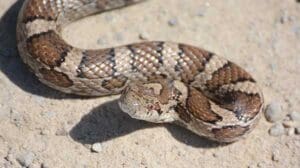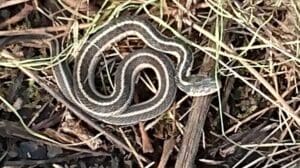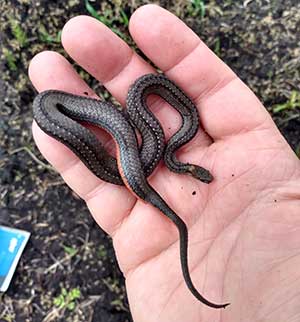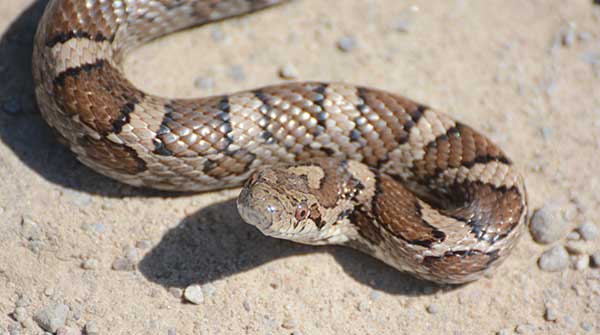There are 28 species of snakes in Canada. Can you name them all?
 For most people, one simply has to mention a snake and they cringe. If asked why, few would ever say they had a negative encounter with one or even know why they’re fearful.
For most people, one simply has to mention a snake and they cringe. If asked why, few would ever say they had a negative encounter with one or even know why they’re fearful.
In Canada, one might find 28 species of snakes, with only a few being venomous. The only poisonous one found in eastern Canada is the Eastern Massasauga.
Can you name all 28? See the end of the column for the complete list.
So, let’s look a little more closely at them. Snakes are generally unobtrusive loners that prefer to avoid conflict with people, predators and even other snakes, quietly going about their business unless threatened.
 Fox Snake |
 Eastern Garter Snake |
 Red-bellied snake |
| Related Stories |
| The remarkable comeback of Wild Turkeys in Ontario
|
| The astonishing sounds fish make
|
| Do Japanese Beetles taste yucky?
|
Here’s a quickie’ Coles Notes’ summary about snakes in general:
They range from worm-like blind snakes to huge constrictors to marine snakes to pit vipers. They can climb trees, swim in the ocean or other bodies of water, or stay on the land exclusively. They can be diurnal (daytime) or crepuscular (dawn and dusk) or nocturnal (night) and eat everything including birds, eggs, mammals, insects, arthropods, other reptiles and amphibians, fish, snails and slugs!
They can kill by crushing their prey or injecting venom into it. With backward-pointing teeth in many species, they swallow prey whole and slowly digest it over several hours or days. They can lay eggs or bear young live. Finally, they are cold-blooded so need to find sources of warmth to keep their body temperatures elevated.
Another thing that many snakes use in their defence is the ejection of cloacal juices, an annoying, smelly concoction designed to repel predators. Essentially poop (my faithful readers will know I love to talk about poop!), this mixture of feces and urine is often ammonia-rich. It looks like bird droppings and may contain bones, hair, scales, and other indigestible materials leftover from meals.
Where do snakes go in the winter? Well, they can’t migrate, so they have to find other mechanisms for survival. Snakes generally find safe refuge in hollow trees, caves, or, in some cases, in underground, protected areas called hibernacula. In the late fall, before frost sets in, snakes return to previously used sites where they’ve successfully overwintered. These sites must offer critical features, such as being below the frost line and close to the water table (so the snakes do not dehydrate). If they can find these places, they can survive our coldest winters.
Recent studies have shown that some male garter snakes release pheromones mimicking females to attract other males to the hibernaculum so that the communal body heat can be shared. The males come thinking that they can breed with the females. But once they realize they were tricked, they remain because it is too late in the season to find another safe, warm haven for the winter.
Once spring comes, they emerge from these underground locations and often re-engage in the breeding frenzy before heading out on their own solitary life for the summer. Breeding frenzies in snakes like the garter snake are a vigorous affair as the snakes writhe and curl about each other, trying to impress the females.
Now, here’s a bit of trivia that will make you the envy of every party. Did you know that snakes evolved much later than their cousins, the amphibians, and that when they emerged as a new family of animals, they actually had legs and looked more like a lizard than a snake?!
Okay, so now you love snakes. Right? Well, maybe not love, but at least have a better understanding of their complexity and part of their lives.
Answer to the names of Canada’s snakes: Eastern Milk, Eastern Hognose, Northern Water, Lake Erie Water, Eastern Fox, Eastern Massasauga, DeKay’s Brown, Northern Red-bellied, Smooth Green, Northern Ring-necked, Queen, Northern Ribbon, Eastern Garter, Maritime Garter, Eastern Plains Garter, Western Terrestrial Garter, Northwestern Garter, Red-sided Garter, Butler’s Garter, Blue Racer, Eastern/Black Rat, Bullsnake, Northern Rubber Boa, Common Sharp-tailed, Plains Hog-nosed. Desert Nightsnake, Prairie Rattlesnake and Western or Northern Pacific Rattlesnake.
Geoff Carpentier is a published author, expedition guide and environmental consultant.
For interview requests, click here.
The opinions expressed by our columnists and contributors are theirs alone and do not inherently or expressly reflect the views of our publication.
© Troy Media
Troy Media is an editorial content provider to media outlets and its own hosted community news outlets across Canada.


